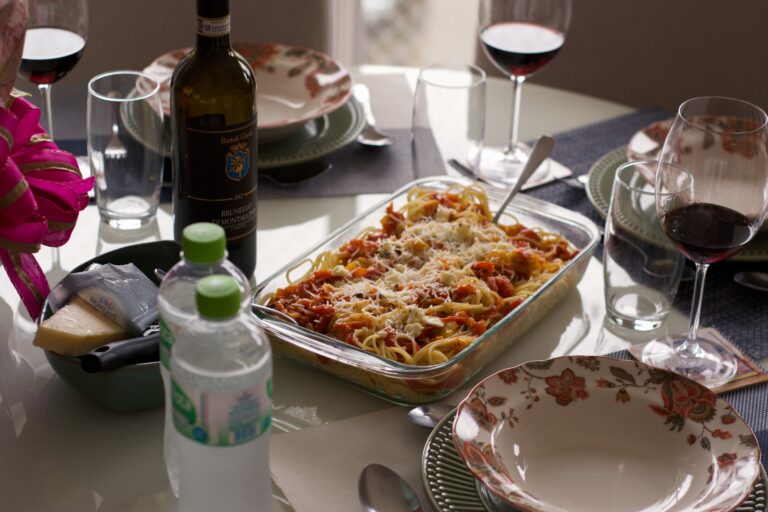In my experience, people tend to have firm opinions when it comes to glass cookware. For every person that loves their glass baking dish or cooking pot, there is another worried that glass might be a bit brittle and crack too easily.
For me, glass cookware evokes happy memories of family lasagnas and good old-fashioned bread butter puddings served straight from the dish.
Nowadays, I couldn’t do without my glass cookware. In this short article, I shall be looking at the pros (and the odd con!) of what I consider to be one of the most versatile cooking materials in the kitchen.
Before getting to the myriad benefits that glass cookware provides, let’s address a few of the elements that can worry people when they consider cooking with glass.

Isn’t it a bit flimsy?
Firstly, the idea that glass cookware can break too easily.
Of course, one must be aware that glass is not as robust as the steel, aluminium, and cast iron more commonly found in the kitchen cupboard.
However, whilst this ‘flimsiness’ certainly used to be a consideration, I have found that today’s glass cookware made from sterner stuff than the fragile dishes of the past.
As long as you are careful with rapid temperature fluctuations (such as adding boiling liquid straight into the dish) and take care not to chip or crack the glass when manoeuvring the cookware in and out of the oven, I am confident that you can find a dish that you can pass onto the next generations of young chefs.
Doesn’t glass burn the food?
Whilst this is a bit of an urban myth, it is based on the reality that glass is a great heat conductor.
This very feature has me reaching for my glass dish whenever I want to cook a dish that requires great ‘browning’.
I use glass for any savoury casserole, macaroni cheese, or pie that would benefit from a little extra colour. Not to mention that leftovers can be put straight back into the fridge in the same dish as glass is great for reheating food.
Also, because it is non-reactive, you don’t need to worry about flavours leaching into the leftovers. Not that there are often many leftovers at our table, however!
However, it is important to remember that, because glass conducts heat so well, it is not always suited to sugar-heavy dishes. Glass can quickly over-caramelize sugars which will lead to unpleasant bitter tastes.
Bear this in mind when you are contemplating sugary desserts in a glass dish!
Surely it’s difficult to get clean?
A few people have told me that they don’t use glass in the kitchen as they worry about keeping it clean. I assure them that, despite the many ‘browned’ dishes that I have made over the years in my glass baking dishes, with proper care and attention, you can keep the glass looking as pristine as the day it arrived.
The first thing to remember is to start by giving the dish a good soak (just make sure that it has cooled sufficiently in advance – don’t forget those temperature fluctuations)
Because glass is non-porous, soaking it is particularly effective for gently releasing any residual food. Glass itself is naturally non-stick.
I would also suggest checking with the manufacturer if they recommend any specially formulated mildly abrasive cleansers for your particular brand.
Another benefit of glass cookware is that it is dishwasher safe so you can pop it straight dishwasher after a good preparatory soak.
Watch a little glass cleaning trick here:
That’s great – is there anything else I should know?
Hopefully, having learned a little about glass cookware, you might now be are considering it for your kitchen cupboard. However, if you’re yet to be convinced, let me outline a couple of other benefits to this greatly underrated cooking material:
Glass is inert. Whilst this might not sound like a positive – it very much is! The fact that glass is inert means that you will get no unpleasant chemicals leaching into your food during the cooking process.
Glass is non-reactive, which means that it is terrific in the microwave. As glass contains no water or metal, the microwave’s energy will heat the food rather than the dish.
Excuse the pun, but another ‘clear’ advantage of glass is that it is see-through. This means that there is no need to remove a lid to see what your food is doing in the oven. You can monitor the cooking process through the oven door. This can be great fun when teaching your little chefs about timings!
Borosilicate and Soda Lime
Without wanting to get too technical, if you are about to head out and look for the best glass cookware for you, it is certainly worth knowing a little about the difference between these two materials.
Soda-lime is the most common kind of glass used for everything from windows to champagne flutes. Around 90% of the glass manufactured in the world is soda-lime.
Borosilicate is a type of glass created using a chemical process that makes this glass incredibly heat resistant. It is probably most famous for its use in Pyrex cookware, a brand that optimises the ‘great thermal and mechanical shock resistance’ of borosilicate.
You might find that glass cookware made from borosilicate is a little more expensive but, in my opinion, it is certainly worth the extra cost.
